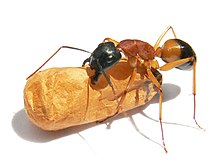Banded sugar ant
| Banded sugar ant | |
|---|---|
 |
|
| Worker with cocoon | |
| Scientific classification | |
| Kingdom: | Animalia |
| Class: | Insecta |
| Order: | Hymenoptera |
| Family: | Formicidae |
| Subfamily: | Formicinae |
| Genus: | Camponotus |
| Species: | C. consobrinus |
| Binomial name | |
|
Camponotus consobrinus (Erichson, 1842) |
|
 |
|
| Distribution of the banded sugar ant | |
| Synonyms | |
|
|
The banded sugar ant (Camponotus consobrinus), also known as the sugar ant, is a species of ant endemic to Australia. A member of the genus Camponotus in the subfamily Formicinae, it was described by German entomologist Wilhelm Ferdinand Erichson in 1842. Its common name refers to the ant's liking for sugar and sweet food, as well as the distinctive orange-brown band that wraps around its gaster.
The ant is polymorphic and relatively large, with two different castes of workers: major workers (also known as soldiers), and minor workers. These two group of workers measure around 5 to 15 millimetres (0.2 to 0.6 in) in length, while the queen ants are even larger. Mainly nocturnal, banded sugar ants prefer a mesic habitat, and are commonly found in forests and woodlands. They also occur in urban areas, where they are considered a household pest. The ant's diet includes sweet secretions that are retrieved from aphids and other insects that it tends. This species is a competitor of the meat ant (Iridomyrmex purpureus), and food robbery and nest-plugging is known to occur between these two ants. Workers prey on insects, killing them with a spray of formic acid. Banded sugar ants are preyed upon by other ants, echidnas, and birds. The eggs of this species were consumed by Indigenous Australians.
The banded sugar ant was first described by German entomologist Wilhelm Ferdinand Erichson, who named it Formica consobrina in 1842. The holotype specimen is a queen collected from Tasmania, which is now housed in the Museum für Naturkunde in Berlin.Formica consobrina was later moved to the genus Camponotus as Camponotus consobrinus, by entomologist Julius Roger in 1863. In 1933, American entomologist William Morton Wheeler described some subspecies and variants of the banded sugar ant. These subspecies were C. consobrinus lividipes and C. consobrinus nigriceps, while the variants were C. consobrinus var. obniger and C. consobrinus var. perthianus. Some of these classifications were short-lived; C. consobrinus nigriceps was later revived as a full species in 1934 as C. nigriceps, while C. consobrinus lividipes was synonymised with C. consobrinus.C. consobrinus lividipes was treated as a subspecies for C. nigriceps in 1985, now known as C. nigriceps lividipes. In 1996 C. consobrinus perthianus was synonymised with C. nigriceps, and C. consobrinus var. obniger was synonymised with C. consobrinus.
...
Wikipedia
